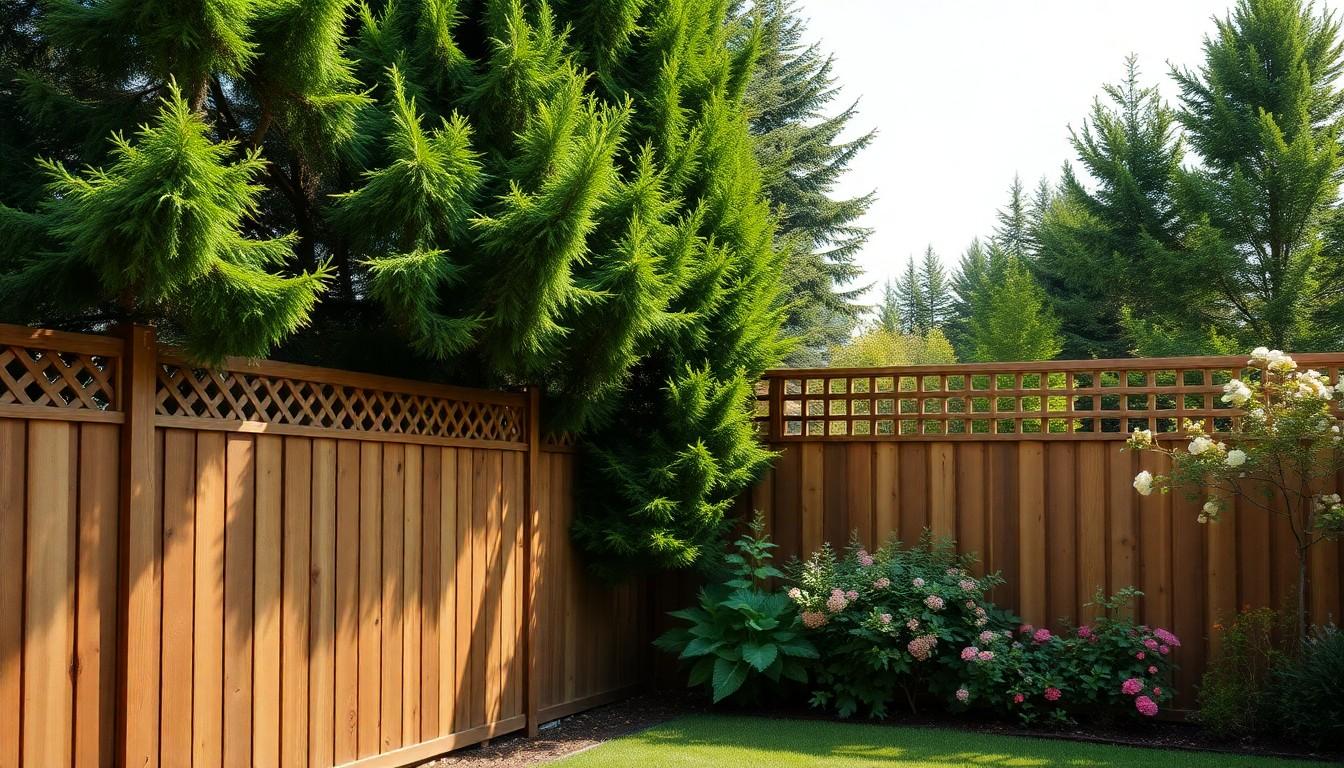In a world where neighbors seem to have a sixth sense for popping up just when you’re about to enjoy a peaceful moment, landscaping for privacy becomes an art form. Imagine sipping your morning coffee without the fear of being scrutinized through a pair of binoculars. With the right plants and design, it’s not just a dream—it’s a reality waiting to unfold in your backyard.
Importance Of Landscaping For Privacy
Landscaping plays a crucial role in enhancing privacy within outdoor spaces. Effective design not only provides a barrier from external views but also creates an inviting atmosphere. Numerous plant species offer natural screens, helping to block unwanted sightlines. Tall hedges, dense shrubs, and strategically placed trees can significantly limit visibility, fostering a sense of seclusion.
The aesthetic appeal of landscaping contributes to overall property value. Attractive green spaces attract potential buyers, highlighting well-designed privacy solutions. Enhancing curb appeal through landscaping shows a commitment to property maintenance and care, which may lead to increased market interest.
Landscaping also aids in noise reduction. Dense foliage can absorb sound, creating a quieter environment. For those living in bustling urban areas or near busy roads, incorporating sound-dampening plants serves as an effective solution to enhance comfort levels.
Privacy-focused landscaping promotes outdoor enjoyment. With a secluded atmosphere, residents can relax and entertain without concern for prying eyes. Outdoor gatherings become more enjoyable, encouraging social interactions in a serene setting.
Safety concerns often drive homeowners to invest in privacy measures. Well-placed trees and shrubs serve as a natural deterrent against trespassing and other security issues. By creating boundaries, landscaping fosters a sense of security, allowing residents to feel at ease in their own homes.
Incorporating water features adds an element of tranquility while enhancing privacy. Features like ponds, fountains, or waterfalls provide soothing sounds that further reduce the awareness of nearby noise and visual distractions. With careful planning, landscaping transforms outdoor areas into private sanctuaries.
Key Elements Of Private Landscaping

Creating privacy in landscaping involves several key components that work together to form secluded outdoor spaces. Effective strategies include fencing options and thoughtful plant selections.
Fencing Options
Solid fences provide an immediate barrier against prying eyes, with wood and vinyl being popular materials. Heights of six to eight feet offer optimal coverage while maintaining aesthetics. Options like lattice-topped fences increase privacy without completely obstructing air circulation and light. Iron or aluminum fences with vinyl slats create a sturdy yet visually appealing choice, allowing for security and privacy simultaneously. Consider local regulations to ensure compliance with height restrictions.
Plant Selections
Choosing the right plants plays a crucial role in enhancing privacy. Evergreen trees like arborvitae and Leyland cypress form dense screens year-round. Dense shrubs, such as boxwood and privet, contribute to layered privacy and can be shaped according to preferences. Grouping plants in staggered rows maximizes coverage and creates a natural barrier. Additionally, flowering plants like lilacs or hydrangeas add visual interest while providing seasonal privacy. Combining height and variety enriches the landscape, fostering a lush, secluded environment.
Design Concepts For Privacy
Creating a private outdoor space involves several design concepts that enhance seclusion and aesthetics. Exploring these options leads to a serene retreat.
Natural Barriers
Natural barriers offer effective ways to achieve privacy in outdoor spaces. Dense foliage from tall shrubs or trees serves as a shield from outside views. Hedges like privet or boxwood grow thickly, providing year-round coverage. Additionally, incorporating layering with various plant heights enhances the visual interest. Using native plants also promotes environmental health and requires less maintenance. Ground cover plants can further fill in gaps, creating a unified screen. This approach is not only practical but also boosts the area’s ecological benefits.
Vertical Gardens
Vertical gardens utilize vertical space creatively for privacy solutions. They can transform blank walls into lush green canvases that enhance seclusion. Installing trellises with climbing plants like ivy or jasmine fosters natural barriers. This method can optimize space, especially in smaller yards, while providing seasonal blooms. Container gardening offers flexibility, allowing the placement of plants at different heights. Utilizing vertical elements, such as panels, encourages visual interest and adds depth. Careful plant selection, including evergreens and flowering varieties, promotes year-round privacy while enhancing aesthetics.
Maintenance Tips For Privacy Landscaping
Maintaining privacy landscaping requires consistent attention to detail. Regular pruning keeps plants healthy and encourages dense growth. Shearing evergreen hedges at least once a year improves their ability to block views. Fertilizing shrubs and trees in early spring promotes lush foliage and overall vigor.
Watering needs vary based on plant species and local conditions. Deep watering during dry spells ensures adequate drought resistance, particularly for young trees. Mulching around the base of plants retains soil moisture and suppresses weeds, contributing to a tidy appearance.
While it’s essential to monitor for pests, recognizing signs of infestation allows for timely intervention. Using organic pesticides can be effective without harming beneficial insects. Additionally, fostering a diverse plant environment attracts natural predators, reducing pest populations.
Seasonal clean-up becomes crucial for maintaining aesthetics. Clearing fallen leaves and debris prevents mold and keeps pathways safe. Checking for dead or damaged branches ensures both safety and visual appeal.
Consider seasonal color changes when designing privacy landscapes. Selecting a mix of evergreens and deciduous plants guarantees year-round interest. Incorporating flowering plants that bloom at different times supports ongoing beauty throughout the seasons.
Using landscape fabric between plants minimizes weed growth, reducing maintenance labor. Installing drip irrigation systems provides optimal water delivery, conserving resources while supporting plant health. Utilizing native plants may lower maintenance needs, as they adapt better to local climates.
For added security, integrating outdoor lighting between and around plants enhances safety. Trimming back overgrown plants opens up sightlines, allowing for better visibility in the yard. Regular assessment of fencing integrity ensures lasting privacy, while necessary repairs maintain barriers against prying eyes.
Conclusion
Landscaping for privacy offers a transformative approach to creating a peaceful outdoor sanctuary. By thoughtfully selecting plants and incorporating design elements, individuals can cultivate an inviting space that shields them from outside views.
This not only enhances enjoyment but also boosts property value and security. With proper maintenance and strategic planning, a lush and serene environment can flourish year-round. Embracing these landscaping techniques allows homeowners to reclaim their outdoor spaces and enjoy the tranquility they desire.

